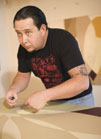

At once handsome and crafty, the paintings created by Alex Couwenberg in his Claremont-area studio may boast clean edges, but they smudge the boundaries of modernist and post-modernist practice. Couwenberg’s work culls loosely—and delectably—from the mid-century modernist lexicon, mixing in aspects of vernacular popular design, as a form of autobiographical sampling. The result is a swoony pastiche that invokes not just hard-edge abstraction, but also skateboard and surf culture, the finish fetish movement, and California car culture, blending them together with lyrical-if-fragmentary verve. Last year, he got a Joan Mitchell Award for his labors. (Notes the artist: “I’m a huge Joan Mitchell fan.”)
A native of the Claremont area, Couwenberg got his BFA from Art Center in 1995 and his MFA from Claremont. “About half way through I realized that I really liked to apply paint to a surface,” he recalls. “I wanted to find a middle ground between expressionism and hard-edge abstraction. I was really into laying down grounds of paint, leaving the hard raw edges but exposing the underpainting, revealing the history of the painting.” While at school, Couwenberg took a class with painter Karl Benjamin, known for his jazzy optical geometries, and Benjamin became his mentor. Yet beyond their superficial homage to the modernist tropes of half a century ago, Couwenberg’s work culls from a wide variety of sources rooted in colloquial design and SoCal popular culture. “I’m a product of Southern California,” he states. “I grew up skateboarding, surfing, around a car culture, I grew up in the 60s with that Southern California design aesthetic... At a certain point, it all clicked.” The influence extends beyond his formal vocabulary; his lacquer finishes often recall car finishes or the varnish finishes seen on surf-or-skateboards. Couwenberg’s surfaces vary dramatically, from loose painterly sweeps to flat matte color fields to elements that seem glossily translucent. All of these, impressively, are devised from acrylic paint, which he mixes in different ratios to attain different effects. His process is complex and non-linear: sanding back into a surface, masking it, adding flat sections with a sponge roller, then often remasking and revarnishing.
Couwenberg is a gleaner of shapes, savoring their implicit allusions and relationships, and he uses his canvasses as Petrie dishes, letting his forms interact with each other like microorganisms. Many of his paintings feature television or soap dish shapes, which he layers like theatrical scrims, to reveal previous stages of the works’ creation. His recent paintings are among his most sumptuous and refined, featuring forms that suggest lozenges, wedges, or flippers from pinball machines, arranged in dynamic asymmetries. (Another family of shapes his work implies: car taillights). The contrast of textures between these glossy windows and the spans of paint surrounding them can be riveting. In May Fair, Couwenberg’s overlapping lozenges are pushed to the bottom of the canvas by outlined flippers in a stark blood orange field. In Hanging Garden, the flippers congregate near the painting’s center, amid a field of twilight black, as larger forms cluster and push in around them. In these newer works, the artist has given more weight to lines, allowing them to delineate his geometric elements, an effect at once subtle and bold. As is typical with Couwenberg, the allusions spin off in contradictory directions, evoking the hard-edge work of Lorser Feitelson, but also automotive pin-striping and hot-rod detailing. (“I’m kind of nutty about getting line right,” he admits.)
For all its seeming polish, Couwenberg’s work is a heartfelt hybrid, both in its spectrum of sources and in its technical balancing act, embracing both rigor and experimentation; despite its backward-looking inflections, his work is staunchly of the present.
Alex Couwenberg’s work could be seen this winter at William Turner Gallery in Santa Monica, from Jan 17 − Feb 21, 2009 and Gilman Contemporary in Sun Valley, ID, from March 1 − April 15, 2009. His newest work can be seen this spring at Peter Blake Gallery in Laguna Beach from June 4 − 25, 2009. In October, his work will be on view at Royale Projects in Indian Wells, CA
This article was written for and published in art ltd. magazine ![]()
